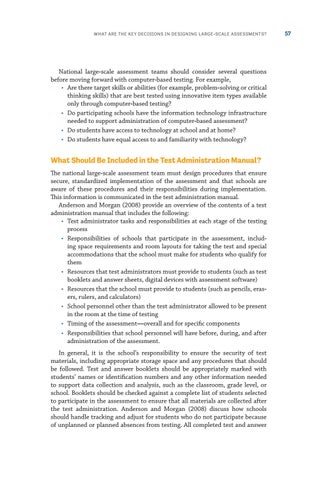What Are the Key Decisions in Designing Large-Scale Assessments?
National large-scale assessment teams should consider several questions before moving forward with computer-based testing. For example, • Are there target skills or abilities (for example, problem-solving or critical thinking skills) that are best tested using innovative item types available only through computer-based testing? • Do participating schools have the information technology infrastructure needed to support administration of computer-based assessment? • Do students have access to technology at school and at home? • Do students have equal access to and familiarity with technology?
What Should Be Included in the Test Administration Manual? The national large-scale assessment team must design procedures that ensure secure, standardized implementation of the assessment and that schools are aware of these procedures and their responsibilities during implementation. This information is communicated in the test administration manual. Anderson and Morgan (2008) provide an overview of the contents of a test administration manual that includes the following: • Test administrator tasks and responsibilities at each stage of the testing process • Responsibilities of schools that participate in the assessment, including space requirements and room layouts for taking the test and special accommodations that the school must make for students who qualify for them • Resources that test administrators must provide to students (such as test booklets and answer sheets, digital devices with assessment software) • Resources that the school must provide to students (such as pencils, erasers, rulers, and calculators) • School personnel other than the test administrator allowed to be present in the room at the time of testing • Timing of the assessment—overall and for specific components • Responsibilities that school personnel will have before, during, and after administration of the assessment. In general, it is the school’s responsibility to ensure the security of test materials, including appropriate storage space and any procedures that should be followed. Test and answer booklets should be appropriately marked with students’ names or identification numbers and any other information needed to support data collection and analysis, such as the classroom, grade level, or school. Booklets should be checked against a complete list of students selected to participate in the assessment to ensure that all materials are collected after the test administration. Anderson and Morgan (2008) discuss how schools should handle tracking and adjust for students who do not participate because of unplanned or planned absences from testing. All completed test and answer
57

